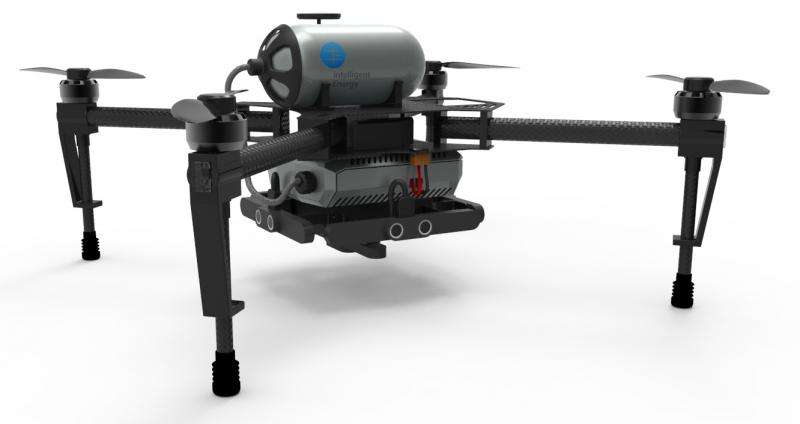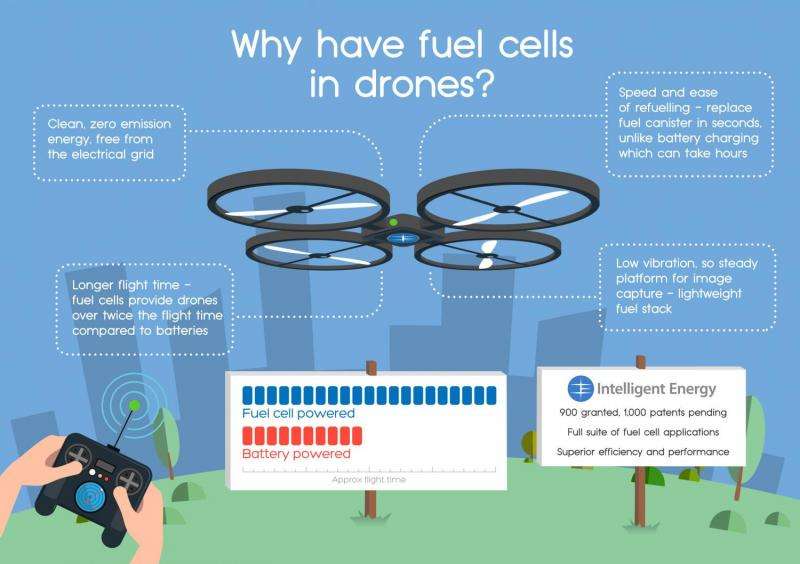December 16, 2015 weblog
Hydrogen fuel cells may turn corner in commercial drone use

A fuel cell can keep drones in flight in hours, not minutes. The company behind the technology will show it at CES 2016.
UK-based Intelligent Energy, an energy technology group, will showcase the fuel cell tech at January's CES in Las Vegas. They announced the prototype on Tuesday.
Adding their hydrogen fuel cell onto a typical battery results in extended flight times from around 20 minutes to several hours.
The announcement described a hybrid fuel cell drone range extender, to be shown at the CES event. Attendees will view the impact which fuel cells can have on devices ranging from smartphones and tablets to drones.
As for drones, the announcement focused on drones as one of the most exciting new technologies but, for commercial use, facing hurdles because of batteries.
For commercial use, they need to offer better flight times and range, said Julian Hughes of Intelligent Energy's consumer electronics division.
The company's business pitch: The release of its range extender platform carries the advantage of longer flight times coupled with quick re-fueling, in turn opening up a range of new commercial possibilities.
Such as? Commercial applications standing to gain would include drones for inspection of offshore platforms, search and rescue, aerial photography, precision agriculture and parcel delivery.
"There's an obvious barrier in battery life," said Julian Hughes, head of the company's consumer electronics division, in an interview, according to the IDG News Service, and the company sought to address that barrier.

"By combining an ultra lightweight fuel cell stack with a battery, Intelligent Energy's range extender offers up to several hours of drone flight time rather than the typical 20 minutes maximum flight times seen today," said the company release. They highlighted not only benefits in lasting longer but also fast re-fueling.
Ben Popper in The Verge said, "because the unit can be recharged with compressed hydrogen, refueling a depleted cell can be accomplished in a few minutes, instead of the 40 minutes to an hour it takes to recharge a typical drone battery."
IDG News Service's Martyn Williams wrote, "The fresh fuel comes in cartridges, and because swapping out a cartridge takes a matter of seconds, the drone can be back up in the air quickly when it gets low on fuel."
Popper quoted Chris Anderson, the CEO of the drone maker 3D Robotics. "For consumers, simply swapping batteries is an acceptable solution to limited battery life. But commercial users, who may be doing high-resolution mapping or scanning, which requires low-speed paths back and forth over an area, the ability to stay in the air for an hour or more can turn what might be many missions into one."
Williams said that prototypes from the company include just using the fuel cell while another is a hybrid in which the fuel cell constantly charges a conventional battery.
Said the news release: "For the past 14 months it has independently tested drones with fuel cell and battery hybrid systems. Flight tests were conducted on two configurations: one solely powered by a hydrogen fuel cell, the other powered by a fuel cell-battery hybrid system. A camera was operated on the test flights and was found to record a steady image with no interruptions, a critical feature for commercial drone use."
More information: www.intelligent-energy.com/new … d-drone-flight-time/
© 2015 Tech Xplore

















